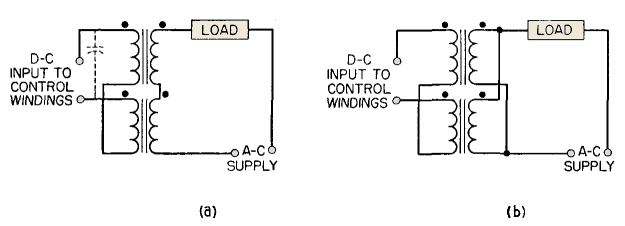| Electronic Transformers and Circuits is a free introductory textbook on transformers and related circuits. See the editorial for more information.... |

|

Home  Magnetic Amplifiers Magnetic Amplifiers  Simple Magnetic Amplifiers Simple Magnetic Amplifiers |
||||||||||||






|
||||||||||||
Simple Magnetic Amplifiers
A single reactor, with a battery-fed d-c source controlling one winding and a-c power fed through the other winding, would have a-c voltage induced in the d-c winding. If this d-c winding were closed only on the battery, it would effectively short-circuit the a-c voltage in the power winding. This difficulty might be overcome by using a high impedance in the d-c control circuit. A more common solution is to use two reactors, one of the d-c windings of which is reversed, while the a-c windings add normally. Connections of this sort are shown in Fig. 203 (a), with the a-c windings in series; it is possible to connect them in parallel as in Fig. 203(b) in order to allow more load current to flow at lower a-c voltage.
When there is zero direct current in the control windings of Fig. 203, both reactor impedances are large and prevent any load current except exciting current from flowing throughout the a-c voltage cycle. AVhen direct current is applied to the control windings, impedance remains large for the first part of a cycle, until saturation flux density is reached. Then reactor impedance is reduced and a large load current may flow. With rectangular B-H loop core material, such as that shown in Fig. 22 (p. 26), the change from high to low impedance is abrupt. If the loop were a true rectangle, the load current wave form would be as shown by iL in Fig. 204(a).
Only the exciting current flows in the load during the interval 0-Θ1. Then saturation is reached and load current suddenly rises to a large value. From Θ1, to π, iL has sinusoidal shape. During the next half-cycle, this load current shape is repeated but in the reverse direction.
In the foregoing it was assumed that control current was free to assume the shape shown in Fig. 204(a). This is true, on a 1:1 turns ratio basis only if the control circuit impedance is small. If total control circuit resistance is denoted by Rc and load resistance by RL, for Rc << RL, load and control currents are sine waves, or portions thereof. If the opposite is true, namely Rc >> RL, control current wave shape is determined by Rc. For very large Rc, control current is continuous, and the current wave shapes approach those in Fig. 204(b). In this figure, d-c source impedance is large, even harmonics cannot flow, magnetization is "constrained," load current is flat-topped, and voltage across the reactor is distorted considerably. This distortion can be overcome by the use of a capacitor across the control coils as shown dotted in Fig. 203(a). When the reactors are parallel-connected, as in Fig. 203(b), even harmonics may flow in the load coils, and capacitors are unnecessary for Rc >> RL. Sometimes the two cores are combined into one, in the manner shown in Fig. 205.
This is called a three-legged reactor, with one d-c coil and two a-c coils. Figure 205 shows the relative paths for the a-c and d-c fluxes. Equal turns in the a-c coils set up equal a-c magnetomotive forces which cancel in the center leg, and cause flux to flow as indicated by the solid line. No fundamental alternating voltage is induced in the d-c coil, but d-c flux flows in both outer legs as indicated by the dotted lines. A change of current in the d-c coil causes a change in total flux linking the a-c coils and hence a change of inductance. A-c coils may be connected in parallel instead of series, provided that equal turns in each coil and the flux polarity of Fig. 205 are maintained; for the same total number of turns the inductance is halved and the alternating current doubled. The middle core leg shunts the even harmonics of a-c flux. Rectangular B-H loops are obtained in grain-oriented core materials. It is only in these materials that the wave shapes of Fig. 204 (a) are even approximated. In unoriented core steel, wave shape is much more rounded, and control current bears less resemblance to load current.
Figures 206 and 207 indicate the contrast in saturation control afforded by unoriented silicon steel and oriented nickel steel. In grain-oriented steel cores there is an approximately linear relationship between d-c ampere-turns per inch and a-c ampere-turns per inch over a large range of flux density. Moreover, the a-c NI/in. for a given d-c NI/in. change but little with a-c flux density over this range. In Fig. 207, each of the lines for a given value of control magnetizing force is nearly vertical. For a given value of control NI/in., load current is almost independent of flux density and therefore of a-c supply voltage. The sections following are based on the use of grain-oriented core steel.
|
||||||||||||
Home  Magnetic Amplifiers Magnetic Amplifiers  Simple Magnetic Amplifiers Simple Magnetic Amplifiers |
||||||||||||
Last Update: 2011-01-24






